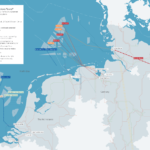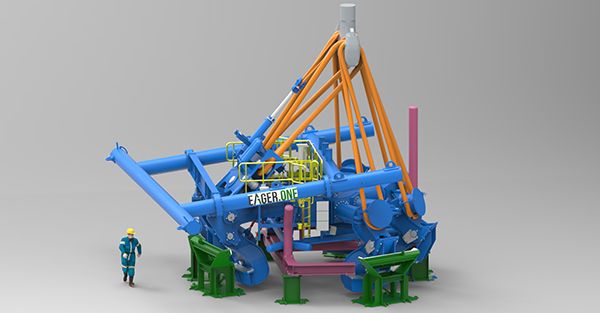TenneT almost doubled investment in grid expansion
Energy Disrupter
General – Grid Expansion TenneT
In the first half of 2023, TenneT almost doubled its investment in grid expansion and replacement, compared to the same period last year.

The €3.5bn investment is in line with TenneT’s expectations and earlier announcements of a growing investment portfolio to support the strong political and its intrinsic ambition to drive the energy transition in the Netherlands and Germany, the company said.
In the first half of 2023, TenneT concluded several exceptionally large and long-term framework agreements to develop high-voltage infrastructure for the energy transition.
These included framework contracts for 14 grid connection systems for offshore wind energy, each with 2GW capacity.
These agreements – which include converter stations, cable systems, transportation, and installation – have a total market value of more than €40bn.
The onshore and offshore high-voltage grid operator’s underlying EBIT increased by €351m to €930m in the first half of 2023.
TenneT chief executive Manon van Beek said: “The huge grid expansion and maintenance task we carry out for the energy transition does not take place overnight. With our hundreds of projects, both onshore and offshore, now and over the next two decades, we are realising the electricity system of the future with a clear end picture in mind: Target Grid 2045. Achieving economies of scale, innovating together with the market, international cooperation and timely and governmental supported long-term infrastructure planning are key in making a carbon-neutral energy system feasible and affordable for households, industries, suppliers and TenneT itself.”
Arina Freitag, TenneT’s CFO, added: “The societal, political, but certainly also financial efforts regarding the energy transition are of unprecedented proportions. TenneT is gearing up for this. We continue to be engaged in discussions with the German government, to explore a sale of TenneT’s German activities to the German State on acceptable terms. Such a transaction would enable the creation of two strong, national Transmission System Operators (TSOs) with a European focus that will continue to closely cooperate, particularly on the North Sea and that are capable of executing our investment agenda of around EUR 111 billion. The recent shareholder contribution of EUR 1.6 billion and the EUR 8 billion credit facility we concluded in this first half of 2023 provide ample financial headroom.”
TenneT concluded several exceptionally large and long-term framework agreements to develop high-voltage infrastructure for the energy transition. These included framework contracts for 14 grid connection systems for offshore wind energy, each with 2GW capacity. These agreements – which include converter stations, cable systems, transportation, and installation – have a total market value of more than EUR 40 billion.
With these agreements, new economies of scale and technical standardisation can be achieved, and TenneT can be certain that the suppliers and necessary grid components will be available on time. They also offer suppliers planning certainty and predictability, which they need to be able to invest in necessary additional resources and facilities.

International cooperation as a must
As political goals for large-scale development of offshore wind energy become increasingly ambitious, cooperation between countries and TSOs is no longer a choice. Closer international cooperation is needed to come to a more robust European energy system, connecting more diversified energy sources – including increasing amounts of wind and solar – to maintain a high level of security of electricity supply. This applies especially to offshore energy hubs and hybrid interconnectors.
In May this year, TenneT and National Grid Ventures announced LionLink, a new multi-purpose interconnector (MPI) between the Netherlands and the United Kingdom. As well as being an interconnector, it will also transport wind energy from a future 2GW Dutch offshore wind farm. The development is the first of its kind for the UK and the Netherlands, and the first step towards an integrated North Sea grid.
Thanks to innovations like the MPI and the new 2GW standard for offshore grid connection systems, TenneT is playing an important role in developing the North Sea as the powerhouse for Northwest Europe. Together with five other TSO’s, TenneT showed in April 2023 how to achieve large-scale expansion of offshore wind energy in Europe in the joint expert paper The Esbjerg Cooperation: transforming the North Sea into Europe’s green power plant.
With the introduction of Target Grid 2045, TenneT provides a clear design and approach to ensuring that the high-voltage infrastructure at sea and on land needed for a sustainable energy system is completed efficiently and is ready by 2045. Target Grid proposes an internationally meshed grid of direct current (DC) electricity ‘superhighways’ and energy hubs, as well as significant improvements to the existing alternating current (AC) grid.
This combination of energy hubs – connected by DC superhighways – ensures that renewable electricity can be transported over long distances from the North Sea to consumers and industry and that the electricity network remains reliable and secure.
Other important developments in H1 2023
The nitrogen impasse in the Netherlands is impacting electricity grid operators. As a result, projects to expand the electricity grid are facing major delays. In TenneT’s case, more than 13 projects have been delayed. If no structural solution is found, almost 100 TenneT projects could be delayed in the longer term. This is an undesirable development, as the very purpose of the investments is to solve and prevent congestion, and to ultimately contribute to reducing nitrogen emissions. The massive switch to heat pumps, solar panels, electric transport in households and accelerated plans for electrification by businesses is growing faster than the pace at which grid expansions can be executed. As a consequence, the grid is at full capacity in several regions. Grid operators make great efforts to expand the grid and are also developing solutions for the shorter term. To reduce grid congestion in the coming years, grid operators are encouraging businesses and industry to avoid using the grid in peak hours. Unfortunately, interest has been low so far. The National Action Plan aims to provide further insights for businesses, deliver better information and improve incentives for flexibility.
In the Netherlands, TenneT delivered the 700 MW offshore grid connection system for Hollandse Kust (Noord). With this, TenneT achieved the objectives of the ‘Offshore Wind Energy Roadmap 2023’ on time and within budget.
TenneT’s 13th offshore grid connection system in Germany, DolWin6, has been in trial operation since the end of May. After successful completion, DolWin6 is preparing for final acceptance in autumn 2023 as planned.
The largest new 380 kV onshore grid connection between Eemshaven and Vierverlaten (40 km) is fully operational, including a new high-voltage substation the size of 25 football pitches.
The construction of SuedLink and SuedOstLink, two of Germany’s largest energy transition infrastructure projects, can start. For SuedLink, the first DC cables of a total of 2,400 kilometres of ground cables are ready and TenneT has completed the necessary permit procedures for the complex Elbe crossing.
The construction of SuedOstLink was kicked off by the Minister for Economic Affairs and Climate Action, Robert Habeck, through a symbolic first spade in the ground for the construction of a new high-voltage substation near Magdeburg.
Original Source: https://ocean-energyresources.com/2023/07/28/tennet-almost-doubled-investment-in-grid-expansion/

















